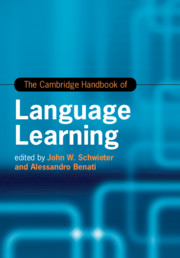Book contents
- The Cambridge Handbook of Language Learning
- Cambridge Handbooks in Language and Linguistics
- The Cambridge Handbook of Language Learning
- Copyright page
- Contents
- Figures
- Tables
- Contributors
- Acknowledgements
- Introduction
- Part I Theories
- Part II Methods
- Part III Skill Development
- Part IV Individual Differences
- Part V Pedagogical Interventions and Approaches
- 20 Pedagogical Interventions to L2 Grammar Instruction
- 21 Task-Based Language Learning
- 22 Task and Syllabus Design for Morphologically Complex Languages
- 23 Proficiency Guidelines and Frameworks
- 24 Technology-Mediated Language Learning
- 25 Content-Based L2 Teaching
- 26 Conceptions of L2 Learning in Critical Language Pedagogy
- Part VI Context and Environment
- Part VII Moving Forward
- Index
- References
25 - Content-Based L2 Teaching
from Part V - Pedagogical Interventions and Approaches
Published online by Cambridge University Press: 25 June 2019
- The Cambridge Handbook of Language Learning
- Cambridge Handbooks in Language and Linguistics
- The Cambridge Handbook of Language Learning
- Copyright page
- Contents
- Figures
- Tables
- Contributors
- Acknowledgements
- Introduction
- Part I Theories
- Part II Methods
- Part III Skill Development
- Part IV Individual Differences
- Part V Pedagogical Interventions and Approaches
- 20 Pedagogical Interventions to L2 Grammar Instruction
- 21 Task-Based Language Learning
- 22 Task and Syllabus Design for Morphologically Complex Languages
- 23 Proficiency Guidelines and Frameworks
- 24 Technology-Mediated Language Learning
- 25 Content-Based L2 Teaching
- 26 Conceptions of L2 Learning in Critical Language Pedagogy
- Part VI Context and Environment
- Part VII Moving Forward
- Index
- References
Summary
The focus of this chapter is content-based language teaching (CBLT), a type of instruction that combines the teaching of academic subjects (such as maths, science, and history) and second or additional language (L2) learning. This “two for one” pedagogical approach aims to integrate content and language by providing learners with opportunities to use their developing L2 as they advance their understanding of a particular discipline. Although CBLT emphasizes the use of content, research suggests that L2 success in content-based classrooms depends, among other things, on the degree to which instruction provides opportunities not only for content-focused communication but also for attention to linguistic forms. In this respect, there are different models of content-based approaches, which differ from one another in the degree to which they focus on content versus form.
- Type
- Chapter
- Information
- The Cambridge Handbook of Language Learning , pp. 597 - 620Publisher: Cambridge University PressPrint publication year: 2019
References
- 4
- Cited by

